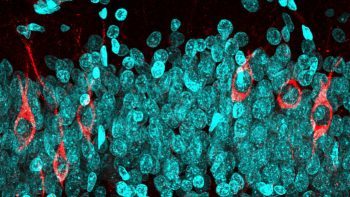Emily Underwood in Science:
 One of the thorniest debates in neuroscience is whether people can make new neurons after their brains stop developing in adolescence—a process known as neurogenesis. Now, a new study finds that even people long past middle age can make fresh brain cells, and that past studies that failed to spot these newcomers may have used flawed methods. The work “provides clear, definitive evidence that neurogenesis persists throughout life,” says Paul Frankland, a neuroscientist at the Hospital for Sick Children in Toronto, Canada. “For me, this puts the issue to bed.” Researchers have long hoped that neurogenesis could help treat brain disorders like depression and Alzheimer’s disease. But last year, a study in Nature reported that the process peters out by adolescence, contradicting previous work that had found newborn neurons in older people using a variety of methods. The finding was deflating for neuroscientists like Frankland, who studies adult neurogenesis in the rodent hippocampus, a brain region involved in learning and memory. It “raised questions about the relevance of our work,” he says.
One of the thorniest debates in neuroscience is whether people can make new neurons after their brains stop developing in adolescence—a process known as neurogenesis. Now, a new study finds that even people long past middle age can make fresh brain cells, and that past studies that failed to spot these newcomers may have used flawed methods. The work “provides clear, definitive evidence that neurogenesis persists throughout life,” says Paul Frankland, a neuroscientist at the Hospital for Sick Children in Toronto, Canada. “For me, this puts the issue to bed.” Researchers have long hoped that neurogenesis could help treat brain disorders like depression and Alzheimer’s disease. But last year, a study in Nature reported that the process peters out by adolescence, contradicting previous work that had found newborn neurons in older people using a variety of methods. The finding was deflating for neuroscientists like Frankland, who studies adult neurogenesis in the rodent hippocampus, a brain region involved in learning and memory. It “raised questions about the relevance of our work,” he says.
But there may have been problems with some of this earlier research. Last year’s Nature study, for example, looked for new neurons in 59 samples of human brain tissue, some of which came from brain banks where samples are often immersed in the fixative paraformaldehyde for months or even years. Over time, paraformaldehyde forms bonds between the components that make up neurons, turning the cells into a gel, says neuroscientist María Llorens-Martín of the Severo Ochoa Molecular Biology Center in Madrid. This makes it difficult for fluorescent antibodies to bind to the doublecortin (DCX) protein, which many scientists consider the “gold standard” marker of immature neurons, she says. The number of cells that test positive for DCX in brain tissue declines sharply after just 48 hours in a paraformaldehyde bath, Llorens-Martín and her colleagues report today in Nature Medicine. After 6 months, detecting new neurons “is almost impossible,” she says. When the researchers used a shorter fixation time—24 hours—to preserve donated brain tissue from 13 deceased adults, ranging in age from 43 to 87, they found tens of thousands of DCX-positive cells in the dentate gyrus, a curled sliver of tissue within the hippocampus that encodes memories of events. Under a microscope, the neurons had hallmarks of youth, Llorens-Martín says: smooth and plump, with simple, undeveloped branches.
More here.
